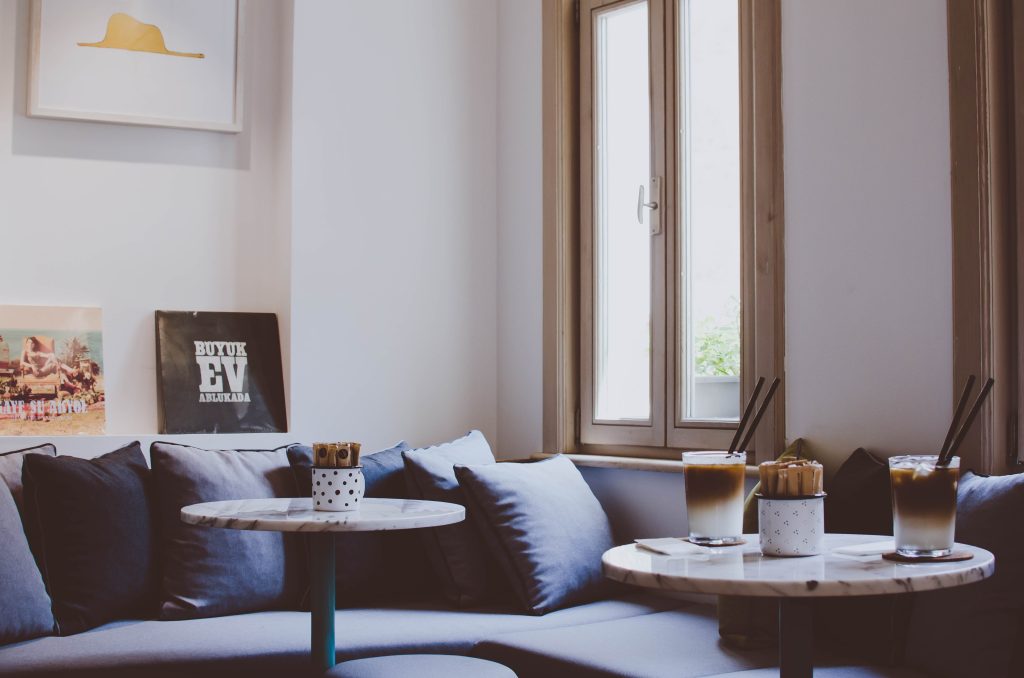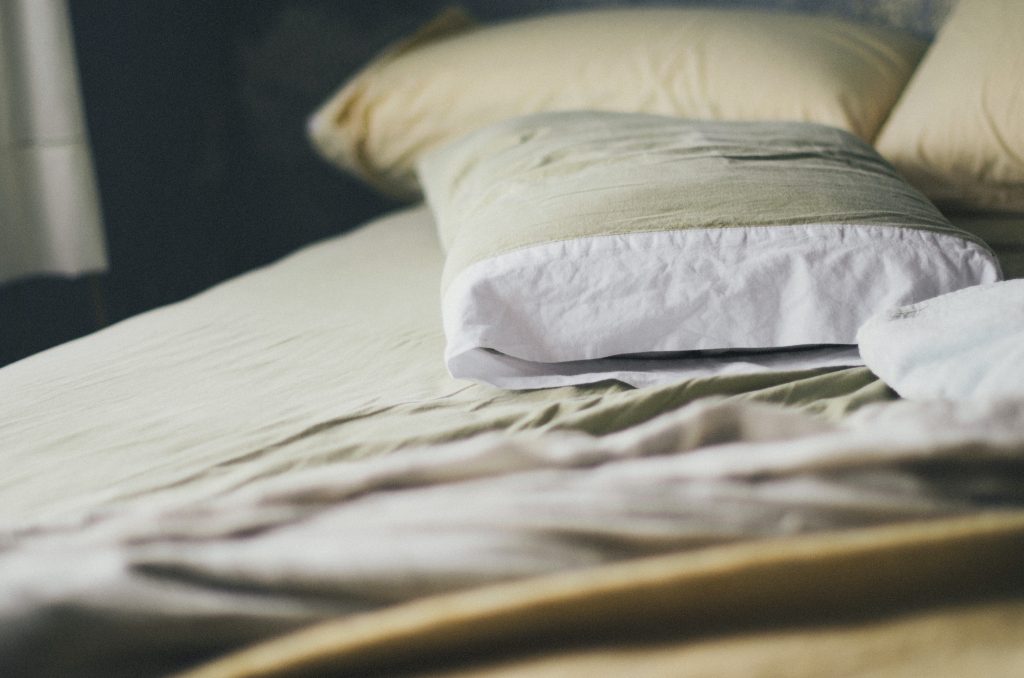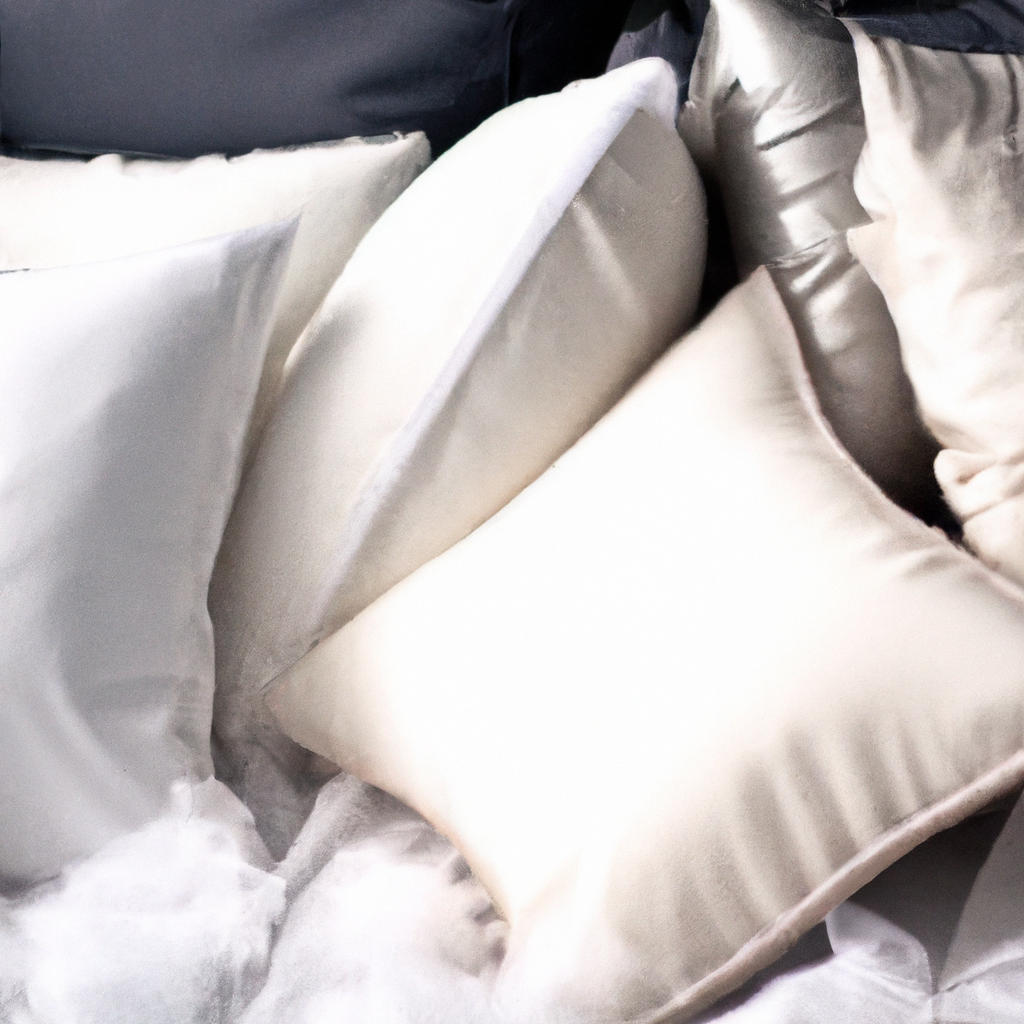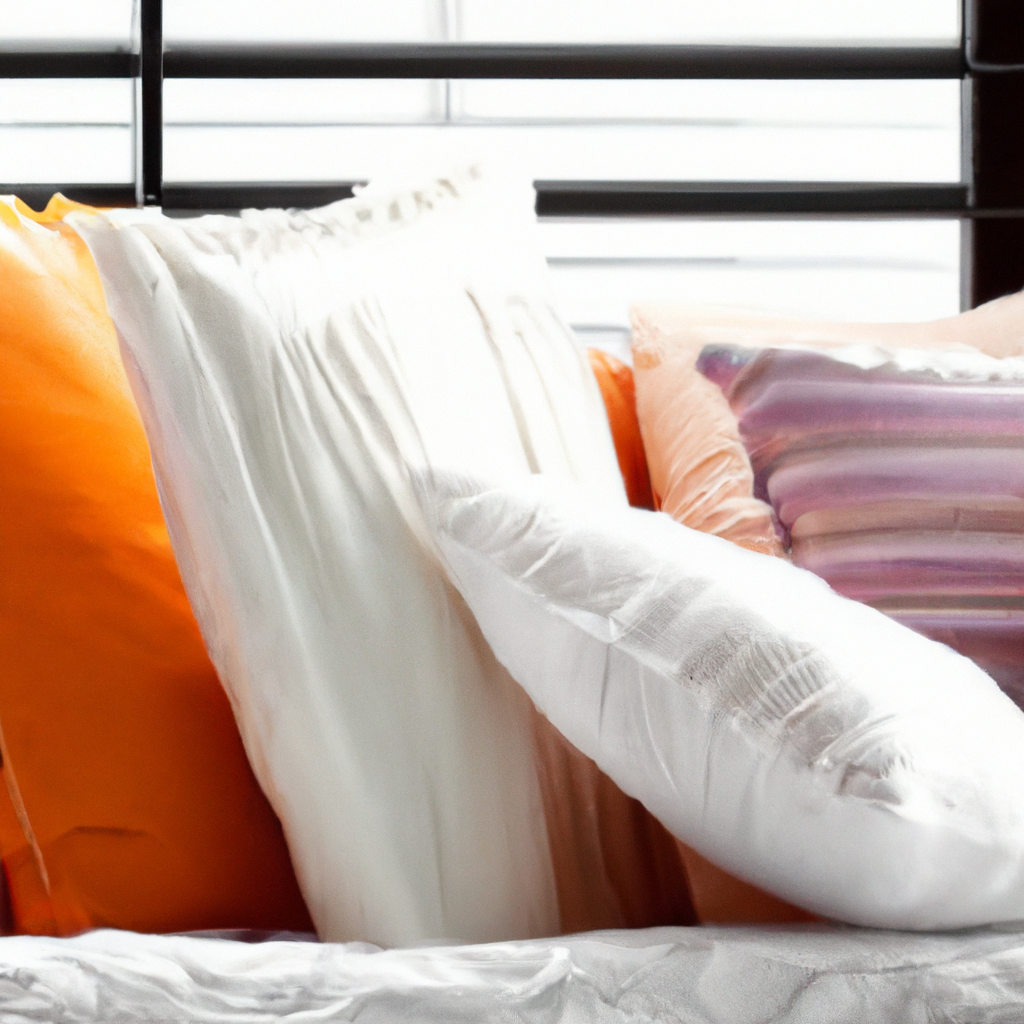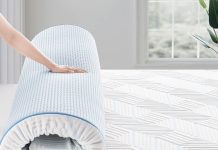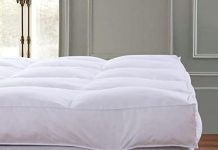In this article, we will be sharing some valuable tips on how to effectively fluff and maintain your pillows for ultimate comfort and longevity. We all know that sinking feeling when our pillows lose their fluffiness and become flat, leaving us tossing and turning throughout the night. Fear not, as we have some simple yet effective techniques that will help you keep your pillows fluffy and supportive, ensuring a restful sleep night after night. So, say goodbye to pancake-like pillows and hello to cloud-like comfort as we dive into the world of pillow fluffing and maintenance.
Review contents
1. Understanding Pillow Types
Pillows come in various types, each designed to cater to different sleep preferences and needs. Understanding these types can help you choose the right pillow for a comfortable and restful sleep.
1.1. Different Types of Pillows
There are several common types of pillows available on the market:
- Memory Foam Pillows: These pillows are made from viscoelastic foam, which contours to the shape of your head and neck for optimal support and pressure relief.
- Down Pillows: Filled with the soft and fluffy feathers found beneath the outer feathers of ducks and geese, down pillows offer a luxurious and cloud-like sleeping experience.
- Feather Pillows: Similar to down pillows, feather pillows are filled with feathers, but they tend to offer less loft and support.
- Latex Pillows: Made from natural or synthetic latex, these pillows are known for their firmness, durability, and ability to maintain their shape over time.
- Polyester Pillows: These pillows are filled with synthetic polyester fibers and are often budget-friendly and hypoallergenic.
- Buckwheat Pillows: These pillows are filled with the hulls of buckwheat seeds, providing natural support, breathability, and adjustable loft.
1.2. Identifying Your Pillow Type
To identify your pillow type, consider the material used for filling, as mentioned above. Additionally, think about your personal sleep preferences and any specific requirements, such as neck or back support, allergies, or temperature regulation.
1.3. Importance of Pillow Maintenance
Proper pillow maintenance is crucial for extending their lifespan and ensuring optimal hygiene and comfort during sleep. Regular maintenance helps combat dust mites, maintains pillow shape, and prevents odor buildup.
2. Daily Maintenance Routine
In addition to regular maintenance, implementing a daily care routine for your pillows is essential for keeping them fresh and fluffy.
2.1. Fluffing Your Pillows
Fluffing your pillows on a daily basis helps distribute the filling evenly, preventing clumps and maintaining proper support. To fluff your pillows, simply plump them up with your hands, squeezing and releasing the filling to restore their shape.
2.2. Regular Air-Out Sessions
Allowing your pillows to breathe by having regular air-out sessions is crucial for preventing moisture buildup. Simply remove the pillowcases and leave your pillows in a well-ventilated area for a few hours, preferably near an open window or outdoors, if weather permits.
2.3. Protecting Your Pillows
Using pillow protectors can help shield your pillows from stains, spills, dust mites, and allergens. Pillow protectors act as an additional barrier between the pillow and the pillowcase, keeping them cleaner for longer periods.
This image is property of images.unsplash.com.
3. Laundering Your Pillows
Even with regular maintenance, pillows can accumulate dirt, oils, and allergens over time. Proper laundering techniques can help maintain their cleanliness and extend their lifespan.
3.1. Pillow Laundering Frequency
It is recommended to wash your pillows every 3-6 months. However, some types, like down and memory foam pillows, might require less frequent washing due to their delicate nature. Always refer to the manufacturer’s instructions for specific laundering guidelines.
3.2. Washing Machine Technique
To wash machine-washable pillows, follow these steps:
- Check the pillow’s care label for specific instructions.
- Remove the pillowcase and pillow protector, if applicable.
- Place the pillows in the washing machine, ensuring there is enough space for them to move freely.
- Add a mild detergent and run a gentle cycle with warm water.
- After the cycle is complete, rinse the pillows twice to remove all soap residue.
- Squeeze out excess water or use a towel to absorb moisture.
- Place the pillows in the dryer, preferably with dryer balls or clean tennis balls to aid in fluffing.
- Dry on a low heat setting, periodically pausing the drying cycle to fluff and redistribute the filling.
- Ensure the pillows are fully dry before returning them to your bed.
3.3. Hand-Washing Technique
For pillows that are not machine-washable or require extra care, hand-washing is the preferred method. Follow these steps:
- Fill a basin or bathtub with warm water and a mild detergent.
- Immerse the pillow in the water and gently agitate it, ensuring the entire pillow gets cleaned.
- Rinse the pillow thoroughly to remove all soap residue.
- Squeeze out excess water and gently press the pillow between towels to absorb moisture.
- Place the pillow on a clean, dry towel in a well-ventilated area to air-dry completely.
4. Drying Methods
Drying your pillows properly is essential to prevent mold and mildew growth. Here are a few drying methods you can use.
4.1. Air-Drying Pillows
Air-drying pillows is a natural and effective way to preserve their integrity. After washing, place the pillows on a clean, dry towel in a well-ventilated area. Rotate the pillows occasionally for even drying. Depending on the climate and humidity, it may take a couple of days for the pillows to completely dry.
4.2. Using a Dryer
Using a dryer can expedite the drying process while ensuring thorough moisture removal. However, it’s important to use low heat settings to prevent damage. Add dryer balls or clean tennis balls to the dryer to help fluff the pillows as they dry. Pause the drying cycle periodically to fluff and redistribute the filling.
4.3. Tennis Ball Trick
The tennis ball trick is a great way to maintain pillow fluffiness while in the dryer. By placing clean tennis balls in the dryer with the pillows, you create agitation that helps redistribute and separate the filling, preventing clumping and improving airflow.
This image is property of images.unsplash.com.
5. Alternative Fluffing Techniques
If you’re looking for alternative methods to fluff your pillows, try these techniques.
5.1. Sun-Drying Method
On a sunny day, take advantage of the natural disinfecting properties of sunlight. After laundering your pillows, hang them outside on a clothesline or lay them flat in a sunny spot. The sunlight helps freshen the pillows and eliminate any residual moisture, leaving them smelling clean and rejuvenated.
5.2. Freezing Your Pillows
Believe it or not, freezing your pillows can be an effective way to fluff and refresh them. Place your pillows in a plastic bag, squeeze out the air, and seal it tightly. Then, put the bag in the freezer for a few hours. The extreme cold helps kill dust mites and freshen the filling, making your pillows feel plumper and more comfortable.
5.3. Vacuuming Your Pillows
Vacuuming your pillows can help remove dust, dead skin cells, and other debris that accumulates over time. Use a brush attachment or a vacuum cleaner specifically designed for upholstery to gently vacuum the surface of the pillow. Be sure to do this on a low or medium suction setting to avoid damaging the pillow.
6. Vacuum-Sealing for Storage
If you need to store your pillows for an extended period, vacuum-sealing them can save space while protecting them from dirt, dust, and moisture.
6.1. Advantages of Vacuum-Sealing
Vacuum-sealing pillows offers several benefits, including:
- Reducing the storage space required.
- Protecting pillows from moisture, dust, and mold.
- Preserving pillow fluffiness and shape.
- Preventing exposure to allergens.
6.2. Step-by-step Vacuum-Sealing Guide
Here’s a step-by-step guide on vacuum-sealing your pillows:
- Ensure your pillows are clean and completely dry.
- Fold or roll the pillows neatly to remove excess air.
- Place the folded or rolled pillows in heavy-duty plastic storage bags.
- Use a vacuum to remove the air from the bags, either by using a vacuum cleaner with a hose attachment or a dedicated vacuum-sealing machine.
- Once the bags are tightly sealed, make sure there are no leaks or openings.
- Label the bags with the date and any additional information.
- Store the vacuum-sealed bags in a cool, dry place away from direct sunlight and extreme temperatures.
6.3. Precautions and Tips
When vacuum-sealing, keep the following precautions and tips in mind:
- Avoid over-compressing pillows, as it may affect their shape and loft.
- Check the bags periodically for any signs of damage or air leakage.
- Avoid storing vacuum-sealed pillows in areas prone to high humidity or extreme temperature fluctuations.
This image is property of images.unsplash.com.
7. Natural Remedies for Fluffing
If you prefer to use natural methods for fluffing your pillows, consider these techniques.
7.1. Sun Exposure and Fresh Air
Exposing your pillows to sunlight and fresh air can help eliminate moisture, odors, and germs that may have accumulated. Hang your pillows outdoors on a sunny and breezy day, allowing the natural elements to freshen and rejuvenate the filling.
7.2. Massaging and Kneading
Gently massaging and kneading your pillows can help restore their shape and fluffiness. Use your hands to press and squeeze the filling, working it from the center towards the edges. This action helps redistribute the filling, remove clumps, and increase the loft.
7.3. Pillows with Natural Fillings
Opting for pillows with natural fillings such as down, feather, or buckwheat can provide inherent fluffiness and resilience. These natural materials tend to maintain their loft and shape without much intervention. Regularly fluffing and shaking these pillows can help maintain their optimal comfort level.
8. When to Replace Your Pillows
Over time, pillows lose their support and accumulate allergens and debris. Knowing when to replace them is essential for maintaining healthy sleep habits.
8.1. Signs of Pillow Wear and Tear
Look out for the following signs that indicate it’s time to replace your pillows:
- Flattened or lumpy filling that doesn’t regain shape.
- Yellowing or discoloration that cannot be washed out.
- Persistent odors, even after cleaning.
- Allergy symptoms worsening despite regular maintenance.
- Signs of mold or mildew growth.
8.2. Lifespan of Different Pillows
The lifespan of pillows varies depending on factors such as the filling material and care routine. As a general guideline:
- Memory foam pillows: 2-3 years
- Down and feather pillows: 5-10 years
- Latex pillows: 5-7 years
- Polyester pillows: 1-2 years
- Buckwheat pillows: 2-3 years
8.3. Choosing a New Pillow
When selecting a new pillow, consider your sleep preferences, support needs, and any specific concerns such as allergies or neck pain. Take the time to test different pillows and consult with experts if needed to find the perfect match for a restful sleep.
9. Hypoallergenic Pillow Options
For individuals with allergies or sensitivities, opting for hypoallergenic pillows can be beneficial. Here are a few considerations when choosing hypoallergenic pillows.
9.1. Choosing Hypoallergenic Fillings
Hypoallergenic pillows often use fillings that are less likely to trigger allergies or sensitivities, such as:
- Synthetic fibers: Look for pillows with hypoallergenic polyester or microfiber fillings.
- Down alternative: These pillows mimic the softness of down without allergenic feathers.
- Natural materials: Some natural materials, like latex and buckwheat, have inherent hypoallergenic properties.
9.2. Maintenance Tips for Hypoallergenic Pillows
To maintain the hypoallergenic benefits of your pillows, follow these tips:
- Regularly clean and air-out hypoallergenic pillows.
- Use hypoallergenic pillow protectors to shield against allergens.
- Avoid exposing hypoallergenic pillows to moisture or extreme temperatures.
9.3. Regular Cleaning for Allergy Control
Cleaning hypoallergenic pillows frequently is essential for allergy control. Follow the laundering techniques mentioned earlier to wash and maintain the cleanliness of your pillows. Regular cleaning helps remove allergens and ensures a healthier sleep environment.
10. Additional Tips and Tricks
Here are a few additional tips and tricks to help you get the most out of your pillows.
10.1. Using Pillow Protectors
Investing in high-quality pillow protectors can significantly extend the lifespan of your pillows. These protectors act as a barrier against stains, sweat, dust mites, and allergens, keeping your pillows cleaner and fresher for longer periods.
10.2. Proper Pillow Positioning
Proper pillow positioning can enhance your comfort and support while sleeping. Ensure your pillows align with your head, neck, and spine, providing adequate support and reducing the risk of neck or back pain. Experiment with different pillow heights and firmness levels to find the most comfortable position for you.
10.3. Choosing the Right Pillowcase
Selecting the right pillowcase material can improve your sleep experience. Opt for breathable, natural fabrics like cotton or bamboo, which promote airflow and wick away moisture. Avoid synthetic materials that can trap heat and lead to discomfort. Additionally, choose a pillowcase with a zipper or envelope closure to prevent the pillow from slipping out during sleep.
By following these tips and tricks for pillow maintenance, you can enjoy the benefits of clean, fresh, and fluffy pillows for a restful and rejuvenating sleep experience. Remember, regular care and attention to your pillows can go a long way in ensuring their longevity and your overall sleep quality.


